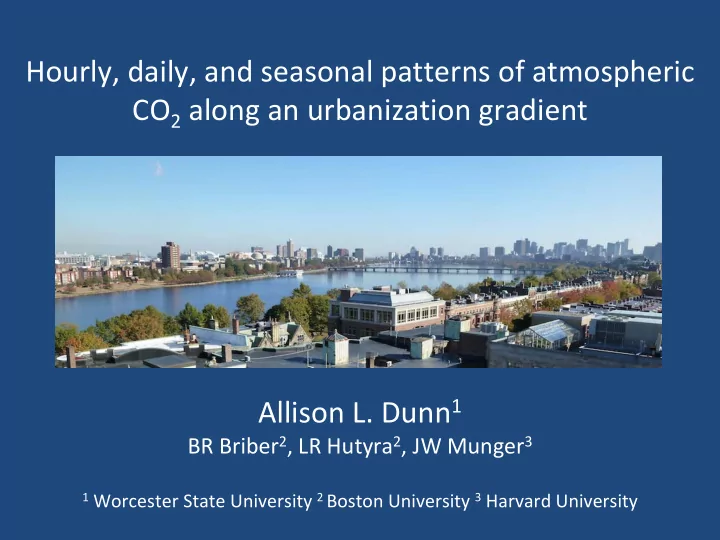

Hourly, daily, and seasonal patterns of atmospheric CO 2 along an urbanization gradient Allison L. Dunn 1 BR Briber 2 , LR Hutyra 2 , JW Munger 3 1 Worcester State University 2 Boston University 3 Harvard University
• Cities comprise ~3% of global land cover (UNFPA, 2007) • Urban areas consume 67% of global energy and emit 71% of the CO 2 worldwide (IEA 2008). • By 2050 up to 70% of the population will live in cities; urban land cover will expand up to 2.5 times its current extent (UNFPA 2007).
Boston Ultra ‐ EX (Hutyra and Philips, BU): “How do humans and their built and natural environments interact to produce geospatially and temporally varied CO 2 exchange in a region?” • Study the urban ‐ rural gradient from Boston to central MA • Use CO 2 to trace natural and anthropogenic processes
Boston Harvard Forest Worcester CO 2 and meteorological measurements being made at: • Boston (high ‐ density, large urban center) – since 2/2010 • Worcester (secondary urban center, close to undisturbed forest) – since 4/2011 • Harvard Forest (forest ‐ dominated) – since 1989
Observations • Average difference between Boston and Harvard Forest largest in summer (16 ppm), smallest in winter (11 ppm) • Weekday CO 2 enhancement largest at Boston (3.3 ppm), smallest at Harvard Forest (0.9 ppm) • Mean CO 2 mixing ratios were 408.2 ± 0.2, 401.5 ± 0.4, and 393.0 ± 0.3ppm at Boston, Worcester, and Harvard Forest, respectively
• Mean CO 2 mixing ratios were 408.2 ± 0.2, 401.5 ± 0.4, and 393.0 ± 0.3ppm at Boston, Worcester, and Harvard Forest, respectively
Boston Worceste Harvard Forest r • CO 2 uptake signal seen at all three locations • Early afternoon minima as biospheric uptake and atmospheric mixing are maximized • Early morning CO 2 maxima reflect buildup of biogenic and anthropogenic emissions under a stable atmosphere
Where next? • Expanding observational network to incorporate new sampling locations: Prudential Building (Boston ), Nahant (coastal north of Boston), UMASS ‐ Boston (on Boston Harbor) • This CO 2 data is being assimilated into a model ‐ data fusion framework to independently infer high ‐ resolution sources and sinks of CO 2 from the spatially dispersed concentration time series
ha ‐ 1 yr ‐ 1 (half Mean fossil fuel CO 2 emissions for MA: ~ 12.3 MgC • from the Boston MSA) ha ‐ 1 yr ‐ 1 Mean CO 2 sink at Harvard Forest: ~2.5 MgC • Atmospheric CO 2 signal integrates biogenic and anthropogenic • processes
Where next? • The Stochastic Time ‐ Inverted Lagrangian Transport (STILT) model is being run on nested domains of 36, 12, 4, and 1.3 km • Combined with a meteorological model (WRF), estimates of urban sources from this project, modeled vegetation sources and sinks • Because STILT is time ‐ inverted, it will directly estimate surface fluxes on the basis of observed concentrations and a priori boundary conditions
Figure courtesy Levi, McKain, and Wofsy • STILT captures the basic timing, shape of CO 2 observations • Model overestimates CO 2 during mid ‐ morning; combination of vehicular emissions, difficulties modeling destratification of PBL, and biospheric transition
Our current observational network is focused on ‘natural’ and managed ecosystems, not on urban regions where emissions dominate. Any future international treaty to reduce emissions of GHGs will require monitoring, reporting, and verification Coupling observations with models is critical to distinguishing natural and anthropogenic sources and sinks of carbon dioxide
Acknowledgements Core Partners Financial Support Lucy Hutyra Steve Raciti Steve Wofsy David Foster Nathan Phillips Curtis Woodcock Mark Friedl Adrien Finzi
Recommend
More recommend